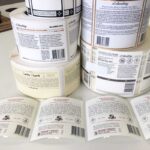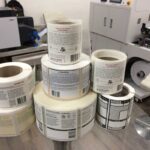Wine Back Label Printing
Shop shelves are now literally bursting with an abundance of types and brands of wine, not to mention the enormous scale of the price range. Those who are confident in their own preferences can pick out their favourite bottles with a confident twist, whereas newcomers might need to work hard to develop a good palate and make a conscious, not at first sight, choice. Of course, experience and personal preference are decisive, but knowing what wine labels hold for you, you can already get an overall picture of what’s in the bottle.
In the realm of beverage label printing, a wine back label acts as a distinct form of identification, similar to a passport. Just as a passport reveals age, birthplace, and other pivotal details without delving into the individual’s personality, a wine back label conveys essential details about the wine. Notably, many countries mandate strict regulations on label content, akin to passport standards.
For the uninitiated: the reverse side of a wine bottle, as per Australian standards, must feature a label in English. This label, adhering to the stringent norms of beverage label printing, should encompass data about the wine’s composition, the producer’s address, and the wine’s age. Additionally, the back label can offer a wealth of knowledge, from the history of the wine-producing region and the climatic conditions favoring grape cultivation to intricate details about the harvesting and production processes.
Generally speaking, the back label of a wine bottle, courtesy of precision beverage label printing, might contain as much, if not more, information than the primary label. The quality of the paper and the standard of printing on the back label can provide insights into the wine’s caliber. A missing back label could cast doubts on the wine’s authenticity.
Wine Back Label history
Of course, such a sophisticated and elaborate system of “wine labelling” has not always existed. The history of the wine label has developed together with the history of the bottle. The first labels appeared in ancient times, though their appearance was far from present-day analogues. The invention of labels was driven by the banal need to identify drinks and know who produced them. Among the “pioneers” of labels were carved inscriptions on earthen vessels used to transport wine in ancient Rome, and charcoal drawings used in the wine industry in Northern Europe. When glass jars for storing wine came into use, sheets of parchment or wooden boards that were tied to the neck of the bottle became the norm.
In the middle of the 19th century craftsmen invented decorating “wine passport” and placed miniature paintings on labels, by the end of the century the so-called anonymous label appeared, in 1919 – a simple name, in the 1950s the majority of producing countries legislatively decided that wine labels should contain complete information about the drink and its producer, while in 1962 the system of appellations controlled by origin was introduced. Of course, there was less and less room for pictures and other creativity on labels, but the regulations did help the fight against counterfeiting and protect the rights of consumers and producers alike.
The wine label is the calling card of the drink. It has to be flawless and appealing to the consumer. Our company provides wine labels printing services of any complexity and volume in a short period of time.
The label will have a unique and eye-catching look.










